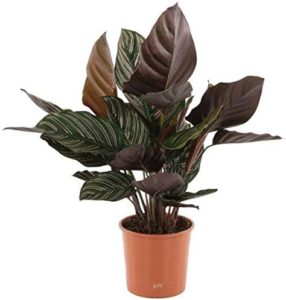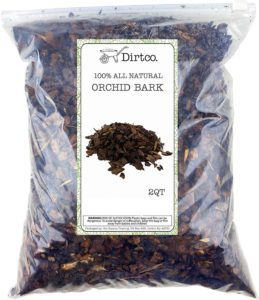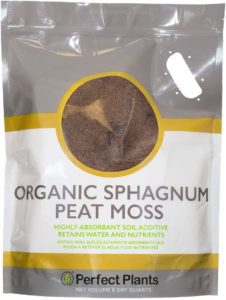Calathea ornata, more commonly known as Pinstripe Plant, is a gorgeous indoor plant that has exotic stripes and beautiful deep colors.
Here’s how to care for calathea ornata.
Other Common Names: Pin-Stripe Plant, Pinstripe Calathea, Prayer Plant
Tags:
- Easy-Care
- Air Purifying
- Pet Friendly
- Low Light
Description
The Calathea Ornata, often referred to as the Pinstripe Plant, is a tropical beauty hailing from the rainforests of South America. Known for its strikingly beautiful, pinstriped leaves that dance in a rhythm (they fold up at night and spread out during the day), this plant is not just a visual treat but also an air-purifying champ.
Its pet-friendly nature makes it a favorite among indoor plant- enthusiasts who have furry friends at home. Whether you’re a newbie or a seasoned plant parent, the Calathea Ornata is sure to add a touch of elegance and freshness to your indoor space.
Facts
| Common Name | Pink Pinstripe Plant |
| Botanical Name | Calathea ornata |
| No. Of Species | Over 300 species in the Calathea genus |
| Family | Marantaceae |
| Biological Life Cycle | Perennial |
| Foliage | Dark green leaves with pink stripes |
| Mature Size | Up to 2 feet tall |
| Time To Maturity | 2-3 years |
| Origin | South America, particularly Colombia and Venezuela |
| Light Conditions | Bright, indirect light |
| Soil Type | Well-draining potting mix with peat |
| Water pH | Slightly acidic to neutral (6.0 to 7.5) |
| USDA Zone | 10-11 |
| Toxicity | Non-toxic to pets and humans, but it’s always best to keep plants out of reach |
Popular Varieties of Calathea Plants:
Calathea plants are like the chameleons of the plant world, always surprising you with their variety! If you’re a fan of the Calathea Ornata, you’ll be thrilled to know there are other equally stunning siblings in its family. Here are some of the show-stealers:
- Calathea Medallion (Calathea roseopicta): This one’s a real show-off with its dark green leaves and feathery, pink-colored patterns. It’s like nature’s own artwork!
- Rattlesnake Plant (Calathea lancifolia): Don’t worry; it doesn’t bite! But its wavy green leaves with unique purple undersides might just make your heart skip a beat.
- Zebra Plant (Calathea zebrina): No zebras were harmed in the naming of this plant! Its striking green stripes will remind you of a zebra’s coat, making it a perfect conversation starter.
- Prayer Plant (Calathea Orbifolia): The star of the show! With its large, round silver-green leaves and distinct dark green stripes, the Orbifolia is a true head-turner. It’s like nature’s own piece of art, adding a touch of elegance to any space.
Remember, each Calathea plant has its own personality and care needs. But with a little love and attention, they’ll thrive and become the star of your indoor jungle!
Pinstripe Calathea Ornata Care Maintenance
The Calathea Ornata, with its origins in the dense jungles, thrives best under conditions that mirror its natural underbrush habitat. To keep this beauty flourishing in your home, it’s essential to recreate that environment.
Let’s dive into the specifics of how to do this.
Light
Best light: Low to medium indirect light
Calathea Ornata isn’t a fan of direct sunlight. In its natural habitat, it’s accustomed to the dappled light filtering through dense foliage. This means that in your home, a spot with low to medium indirect light will be ideal. Too much direct sunlight can fade its vibrant colors, so consider placing it near a north-facing window or using sheer curtains to diffuse the light.

Water
Water needs: Keep the soil consistently moist but not waterlogged. Here’s how much to water calathea plants.
Calathea Ornata prefers its soil to be kept moist, much like the damp jungle floors it’s used to. However, avoid letting the plant sit in water or making the soil too soggy.
You don’t want completely dry soil but you also don’t want too much soil moisture! It’s a delicate balance!
Be sure to use a pot with drainage holes to allow free flowing drainage. Using a saucer can help catch excess water and can help maintain moist soil.
It also helps to check the soil’s moisture level before watering. You can always use a moisture meter to be sure:
Always use distilled water as indoor plants can be quite sensitive to treated tap water, which can lead to crispy leaf edges.
Humidity
This plant loves high humidity! In the wild, it thrives in the humid jungle environment. To replicate this, consider placing a humidifier near the plant or regularly misting it. Grouping it with other plants or placing it in a tray with pebbles and water can also help increase humidity levels around it.
Temperature
Calathea Ornata is sensitive to temperature changes. It prefers a consistent temperature range of 65-75°F (18-24°C). Avoid placing it near drafts, air conditioners, or heaters. Remember, sudden temperature drops or spikes can stress the plant.
Fertilizer
Recommended: Best fertilizers for calathea plants
This tropical plant also isn’t too demanding when it comes to nutrition. Feed it with a balanced liquid fertilizer every month during the growing season (spring and summer). However, in the dormant winter months, you can cut back on feeding to prevent over-fertilization.
Soil
Soil Type: Well-draining mix of perlite, coir, and peat moss
pH level: Slightly acidic, around 6.0 to 7.5
Calathea Ornata prefers a soil mix that retains moisture but also allows for good drainage. A combination of perlite, coir, orchid bark, and peat moss works wonders. These kinds of items allow you to easily keep soil lightly moist. Ensure the soil pH level remains slightly acidic to keep the plant happy.
Repotting
When the Calathea Ornata outgrows its pot or the soil becomes too compacted, it’s time to repot. Choose a pot that’s 1-2 inches larger in diameter. Be gentle during the process to avoid damaging the roots, and always use fresh, well-draining soil.
Propagation
Propagation of the Calathea Ornata plant is typically done through division. During repotting, you can gently separate the plant into smaller sections, ensuring each section has roots attached. This method leverages the plant’s natural growth from nodes and meristem tissue.
Pruning
Pruning helps the Calathea Ornata by mimicking its natural conditions, where larger plants might overshadow it. Regularly trim away any yellow or brown leaves to encourage new growth. This not only keeps the plant looking fresh but also promotes better health.
Pests / Disease
Calathea Ornata plants can sometimes attract pests like spider mites or aphids. These pests usually appear when the plant is stressed or the environment is too dry. Regularly check the undersides of leaves and keep the foliage clean.
If pests appear, consider using insecticidal soap. Overwatering can lead to root rot, so ensure proper watering habits to prevent this.
Pinstripe Calathea Ornata Care Tips
- Mind the Light. Calathea Ornata prefers indirect sunlight. Too much direct sunlight can cause the beautiful pinstripes on its leaves to fade. Place it near a window with sheer curtains or a bit further away from direct light.
- Keep it Humid. This plant thrives in higher humidity. Consider placing a humidifier nearby or occasionally misting the plant to keep the air moist around it. It’ll thank you with vibrant, healthy leaves.
- Watering Wisdom. Wait until the top inch of the soil is dry before watering. Calatheas don’t like to be soaked all the time. Overwatering can lead to root rot, so it’s better to err on the side of caution.
- Watch the Temperature. Calathea Ornata isn’t a fan of cold drafts or sudden temperature changes. Keep it in a spot where the temperature is consistently between 65-75°F (18-24°C).
- Feed it Right. During the growing season (spring and summer), feed your Calathea Ornata with a diluted general-purpose fertilizer every month. In the fall and winter, it’s best to hold off as the plant isn’t actively growing.
Common Problems / FAQs With Calathea Ornata Plants
I’ve written a pretty detailed post about common calathea problems, so look there for more details. Otherwise, here are some common questions and issues people have with calathea plants.
Why are the edges of my Calathea Ornata turning brown?
This is often a sign of low humidity or underwatering of tropical plants. Ensure your plant is in a humid environment and keep the soil consistently moist, but not soggy.
My Calathea’s leaves are curling. What’s wrong?
Leaf curling can be a response to stress, such as sudden temperature changes or overwatering. If you see curling leaves, then check the plant’s environment and adjust accordingly.
The vibrant pink stripes on my Calathea Ornata are fading. Why?
Insufficient light can cause the colors to fade. Place your Calathea in a spot with bright, indirect light to maintain its vibrant colors.
There are yellow spots on my Calathea’s leaves. What should I do?
Yellow spots can indicate a pest infestation, like spider mites. Inspect the plant closely and treat with insecticidal soap or neem oil if pests are found.
My Calathea Ornata isn’t growing new leaves. Is it okay?
It’s possible that the plant is in a dormant phase or it’s not receiving adequate nutrients. Ensure you’re feeding it with a balanced fertilizer during its growing season.













